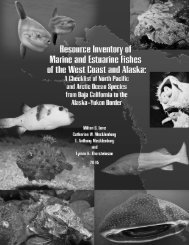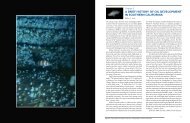Reproductive Ecology and Body Burden of Resident ... - The Love Lab
Reproductive Ecology and Body Burden of Resident ... - The Love Lab
Reproductive Ecology and Body Burden of Resident ... - The Love Lab
You also want an ePaper? Increase the reach of your titles
YUMPU automatically turns print PDFs into web optimized ePapers that Google loves.
Study Area <strong>and</strong> Methods<br />
<strong>The</strong> study area included five oil platforms that extend over a distance <strong>of</strong> 186 km from roughly southwest<br />
<strong>of</strong> Santa Barbara to south <strong>of</strong> Long Beach (Figure 1). To facilitate comparisons <strong>of</strong> elemental concentrations,<br />
each platform was grouped with two nearby natural areas (predominant bottom substrate characteristic<br />
given in parentheses) as follows: Platform Holly with Devereux Reef (hard) <strong>and</strong> Campus Point (s<strong>of</strong>t);<br />
Platform Hogan with Horseshoe Rock (hard) <strong>and</strong> Rincon (s<strong>of</strong>t); Platform Gilda with Santa Cruz Isl<strong>and</strong>—<br />
Coche Point (hard) <strong>and</strong> Northeast Santa Cruz Isl<strong>and</strong> (s<strong>of</strong>t); Platform Gina with Anacapa Isl<strong>and</strong>—Arch Rock<br />
(hard) <strong>and</strong> Hueneme Submarine Canyon (s<strong>of</strong>t); <strong>and</strong> Platform Edith with Catalina Isl<strong>and</strong>—Blue Cavern<br />
(hard) <strong>and</strong> an unnamed locality <strong>of</strong>f San Pedro (s<strong>of</strong>t). <strong>The</strong> five groups <strong>of</strong> oil platforms <strong>and</strong> natural areas were<br />
collectively referred to as habitat types, or “HabTypes,” with oil platforms progressively coded in a roughly<br />
northwest to southeast direction as PL1, PL2, etc., <strong>and</strong> their corresponding natural areas coded as NA1, NA2,<br />
etc. (see Table 1 for codes <strong>and</strong> additional information).<br />
Santa Barbara<br />
1A<br />
1B<br />
1C<br />
Group 1 Group 2<br />
Santa Cruz Isl<strong>and</strong><br />
3B<br />
2B<br />
2A<br />
2C<br />
Group 3<br />
3C<br />
3A<br />
Anacapa<br />
Isl<strong>and</strong><br />
4B<br />
4A<br />
Group 4<br />
Oxnard<br />
4C<br />
C A L I F O R N I A<br />
Los Angeles<br />
Area<br />
Detailed<br />
Sampling Sites:<br />
1A Platform Holly<br />
1B Devereaux Reef<br />
1C Campus Point<br />
2A Platform Hogan<br />
2B Horseshoe Rock<br />
2C Rincon<br />
3A Platform Gilda<br />
3B Santa Cruz Isl<strong>and</strong> – Coche Pt.<br />
3C NE Santa Cruz Isl<strong>and</strong><br />
4A Platform Gina<br />
4B Anacapa Isl<strong>and</strong> – Arch Rock<br />
4C Hueneme Submarine Canyon<br />
5A Platform Edith<br />
5B Catalina Isl<strong>and</strong> – Blue Canyon<br />
5C Unnamed locality <strong>of</strong>f San Pedro<br />
Santa Barbara Isl<strong>and</strong><br />
N<br />
0 10 20 30 40<br />
Kilometers<br />
Group 5<br />
5B<br />
Catalina Isl<strong>and</strong><br />
Long Beach<br />
5C 5A<br />
Figure 1. Map <strong>of</strong> the study area showing locations <strong>of</strong> five oil platforms <strong>and</strong> 10 natural areas. Each platform is grouped with two<br />
nearby natural areas.<br />
3




